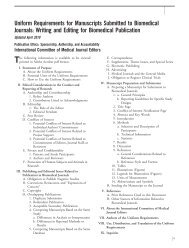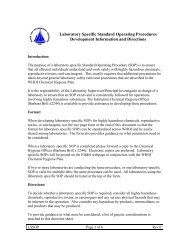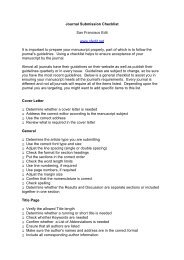Guidance for Preparing Standard Operating Procedures (SOPs)
Guidance for Preparing Standard Operating Procedures (SOPs)
Guidance for Preparing Standard Operating Procedures (SOPs)
You also want an ePaper? Increase the reach of your titles
YUMPU automatically turns print PDFs into web optimized ePapers that Google loves.
Data ML005<br />
Rev. # 0.0<br />
Date: 11/00<br />
Page 9 of 16<br />
6.8 Analytical Spikes: Some tests (e.g., GFAA) make routine use of analytical spikes.<br />
The limits on the recovery of the analytical spikes is given in the analysis SOP.<br />
Verify that these limits are met, and that the software is flagging those outside the<br />
limits.<br />
6.9 Matrix Spikes: Verify that matrix spikes were analyzed at the required frequency,<br />
and recoveries are within the limits stated in the analysis SOP. Laboratory policy<br />
is to include a matrix spike/duplicate pair <strong>for</strong> every 10 samples, with a minimum of<br />
one <strong>for</strong> each batch from a survey. This frequency may be increased or decreased at<br />
the discretion of the client, group leader, or sample management. Preapproval is<br />
required. The limits <strong>for</strong> recoveries are evaluated against the required acceptance<br />
criteria in the QA Project Plan. A recovery outside of limits has a much greater<br />
weight when the result <strong>for</strong> the analyte is near the action level given in the QA<br />
Project Plan. The matrix duplicate has a bearing on the evaluation of the matrix<br />
spike, as is explained in the next section.<br />
6.10 Matrix Duplicates: Verify that the matrix duplicates are analyzed at the required<br />
frequency, and RPDs or absolute differences are within the limits stated in the<br />
analytical SOP. As <strong>for</strong> spikes, laboratory policy is to include a matrix<br />
spike/duplicate pair <strong>for</strong> every 10 samples, with a minimum of one <strong>for</strong> each batch<br />
from a survey. This frequency may be increased or decreased at the discretion of<br />
the client, group leader, or sample management. Preapproval is required. The<br />
limits <strong>for</strong> RPDs or absolute differences are evaluated against the acceptance<br />
criteria in the QA Project Plan. A difference outside of limits has a much greater<br />
weight when the result <strong>for</strong> the analyte is near the action level given in the QA<br />
Project Plan. The matrix spike/duplicate pair should be evaluated together <strong>for</strong><br />
evidence of sample homogeneity problems. The sample description in the narrative<br />
is of aid in this evaluation. A QA Project Plan may call <strong>for</strong> matrix spike duplicates<br />
in place of separate matrix spikes and duplicates. In that event, the two matrix<br />
spikes are evaluated separately as matrix spikes, and the pair is evaluated as above<br />
<strong>for</strong> a sample/duplicate pair.<br />
6.11 Digestion Blanks (LRB): Verify that digestion blanks were prepared and analyzed<br />
at the required frequency. Ordinarily, this will be the same frequency as the matrix<br />
spikes and duplicates. For large batches, a lesser number of blanks may be<br />
prepared with pre-approval from the group leader, so long as it meets the needed<br />
acceptance criteria. The limit <strong>for</strong> analytes reported to the reporting level is the<br />
MDL. If all samples in the analysis run either in the grouping either just be<strong>for</strong>e or<br />
just after a blank above the MDL are more than 10 times greater than the result in<br />
QA/G-6 E-9<br />
March 2001







